The prominence of Korean contemporary art in the international art scene has risen significantly in the post-pandemic era. A new generation of Korean women artists born since the 1980s is gaining unprecedented attention from major institutions and galleries worldwide.
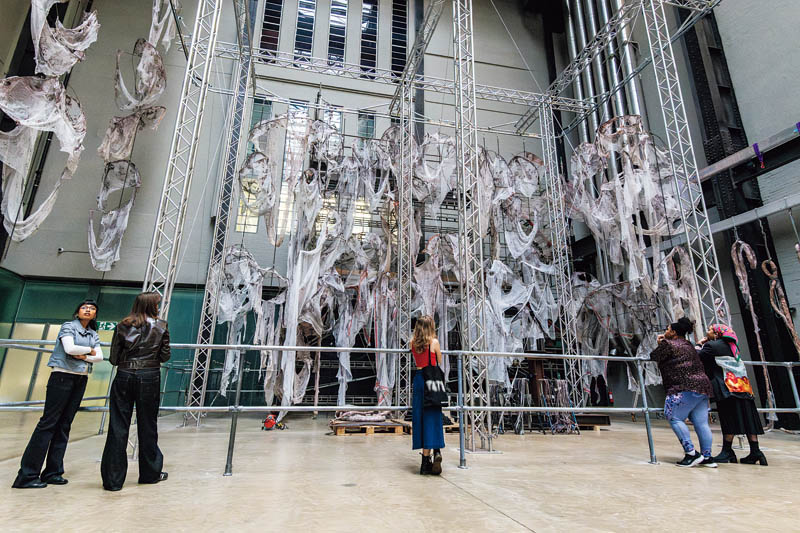
Mire Lee’s Open Wound, on display in the Turbine Hall of London’s Tate Modern gallery in 2024.
© Tate, Photo by Larina Fernandes
The rise of Korean contemporary art, in particular the work of younger women artists, has coincided with significant shifts in the global art world. Major institutions are actively diversifying their programs, while the expansion of the art market has created unprecedented opportunities for younger voices. The soaring global popularity of Korean culture has also provided fertile ground for young Korean women artists to gain international recognition. Born after the 1980s, these artists benefited from Korea’s gradual democratization and growing openness, experiencing an upbringing very different from previous generations — a factor that deeply influences their artistic expression. As a result, younger artists are now increasingly acknowledged for their innovative approaches to contemporary global issues like gender, the environment, and cultural identity, their distinctive artistic languages resonating strongly with audiences around the world.
Moving beyond geographical and cultural boundaries, these artists examine such issues through several distinct lenses: the relationship between technology and human vulnerability, the evolution of cultural traditions in diasporic contexts, and the shifting boundaries of identity in the digital age. Standing out among them are Mire Lee, Zadie Xa, and Geumhyung Jeong.
MIRE LEE
While now receiving wide acclaim, many of these younger Korean artists have been primarily shaped by Korea’s cultural environment rather than experience or education abroad. Mire Lee exemplifies this change; despite her international presence, she completed her formal art education in Korea. Her 2024 Turbine Hall commission at Tate Modern in London represents this new chapter in Korean contemporary art, Lee being the first Korean and the youngest-ever artist to be commissioned for the Turbine Hall. Her Open Wound installation transforms the space into a visceral environment where mechanical systems and organic forms merge and pulse. The project builds on the themes Lee developed in her breakthrough presentation Endless House: Holes and Drips at the 2022 Venice Biennale and her acclaimed ZOLLAMT MMK exhibition Look, I’m a Fountain of Filth Raving Mad with Love, held in Frankfurt the same year. In these installations, industrial materials and kinetic elements create deeply emotive environments that explore violence, vulnerability, and desire.
Featuring oozing liquids and organic materials, Lee’s works paradoxically require remarkable technical precision to achieve their almost creature-like movements. Her work at ZOLLAMT MMK exemplified this contrast, using cold concrete and kinetic elements to evoke intensely corporeal sensations. At Tate Modern, Lee intensifies this industrial-organic tension by transforming the former power station’s monumental space. A seven-meter-long turbine, suspended from the original crane inside the hall, merges with tentacle-like silicone tubes that pump viscous red-brown liquid reminiscent of bodily fluids. The space becomes a hybrid environment where industrial architecture meets organic forms, further emphasized by fabric “skins” that absorb the liquid and then dry and harden, creating an evolving installation that seems both manufactured and alive.
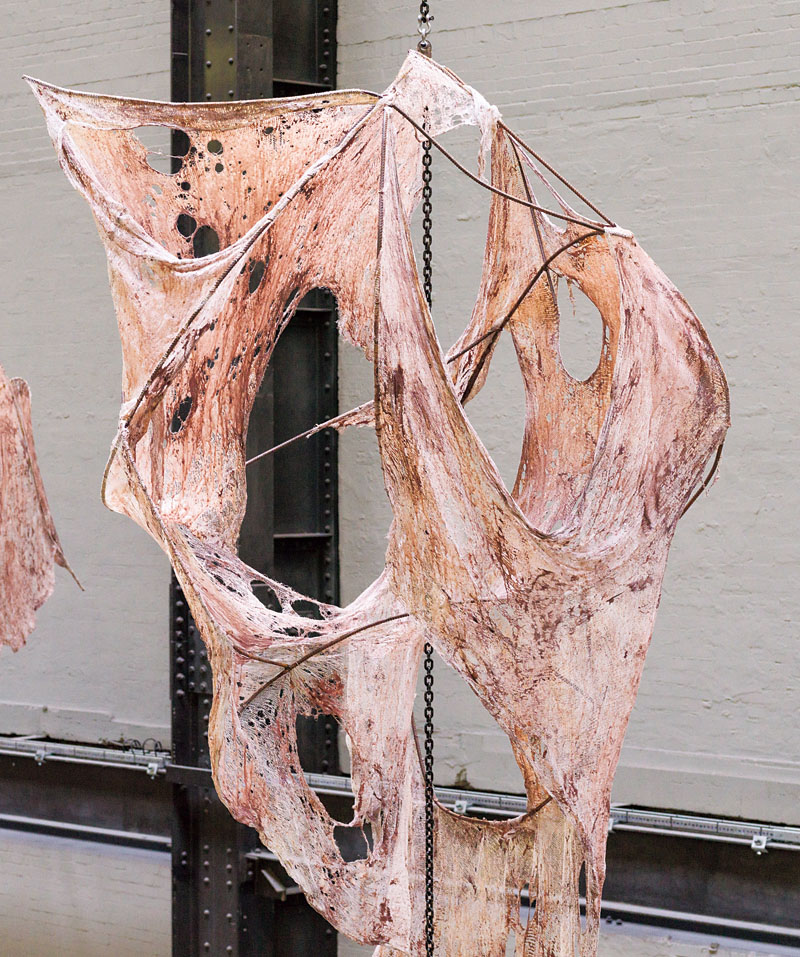
Some of the installations of Mire Lee’s Open Wound. Lee was the youngest and Korea’s first artist ever to showcase her work in the Turbine Hall.
© Tate, Photo by Larina Fernandes
GEUMHYUNG JEONG
Geumhyung Jeong exemplifies a new generation of Korean artists who are building their domestic and international careers simultaneously, rather than establishing themselves locally before seeking global recognition. After her 2018 solo exhibition at SONGEUN Art Space in Seoul, Jeong quickly expanded her international presence with exhibitions at Kunsthalle Basel in Switzerland (2019) and Fondazione Modena Arti Visive in Italy (2020). Her recent ICA London exhibition Under Construction (2024) — featuring complete human skeleton models appended with machine parts that explore the boundaries between organic and technological forms — marks another milestone in this parallel trajectory.
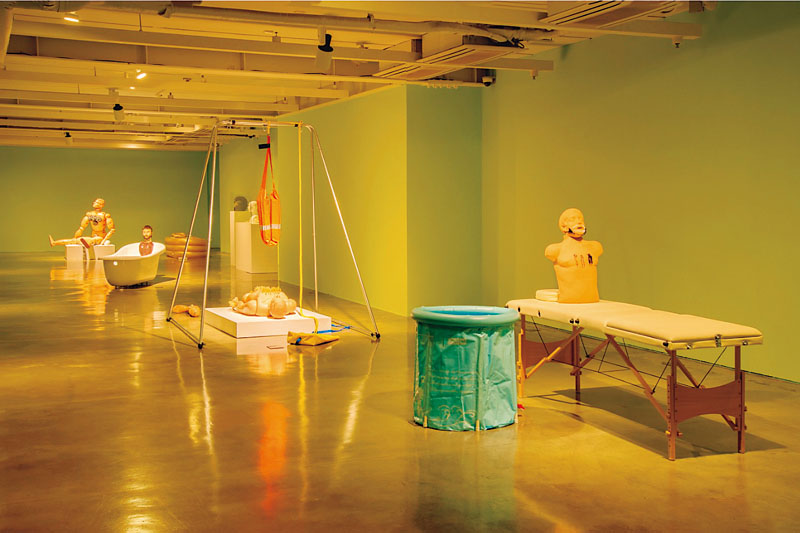
SPA & BEAUTY Seoul by Geumhyung Jeong, held at SongEun Art Space in 2018.
Courtesy of SongEun Art and Cultural Foundation, Photo by Kanghyuk Lee
Through performative interactions with medical mannequins and industrial robots, Jeong studies the connection between humans and machines. Rather than treating machines as abstract systems, she develops tender, sometimes unsettling relationships with them through extended performances. The installation at the ICA featured these hybrid objects, with traces and materials from her performances remaining in the exhibition space. Her timed performances during the show activated these objects as co-performers, furthering her investigation of physical relationships between humans and machines. Jeong, who has a background in choreography, has garnered attention beyond the visual arts world with her highly individual approach. In 2023, at the invitation of fashion designer Miuccia Prada, she transformed Miu Miu’s fall/winter runway show in Paris into one of her performance pieces, bringing her exploration of human-object relationships to the international fashion scene.
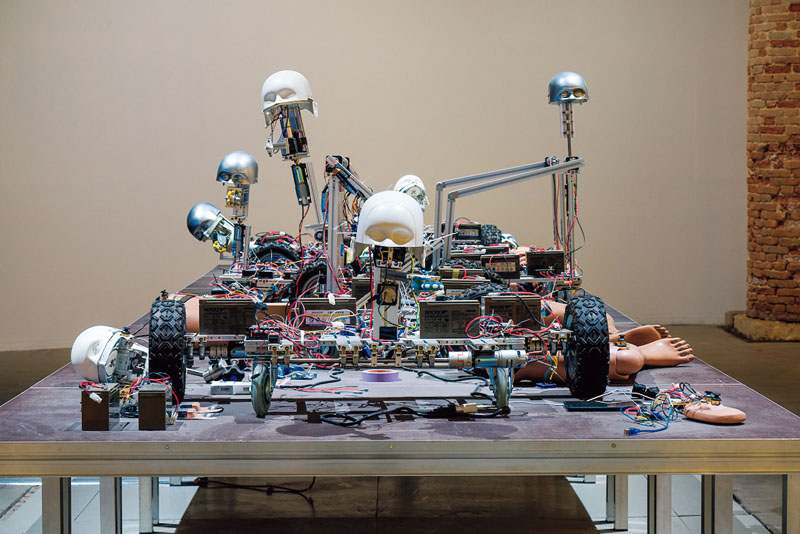
Part of Geumhyung Jeong’s Toy Prototype, invited to the main exhibition of the 59th Venice Biennale in 2022.
Courtesy of La Biennale di Venezia, Photo by Andrea Avezzù
ZADIE XA
Vancouver-born, London-based artist Zadie Xa represents a significant voice from the Korean diaspora, drawing deeply from her cultural roots and diasporic identity. Her emergence as a prominent artist parallels broader cultural shifts, as the descendants of mid-to-late 20th century Korean immigrants to the Americas come of age and begin reshaping contemporary artistic discourses. Through a dynamic combination of performance and textile art as well as video, sound, and multimedia installations, Xa weaves together Korean shamanic traditions with diasporic experiences of our time, creating works that resonate with cultural specificity and universal themes of identity and belonging.
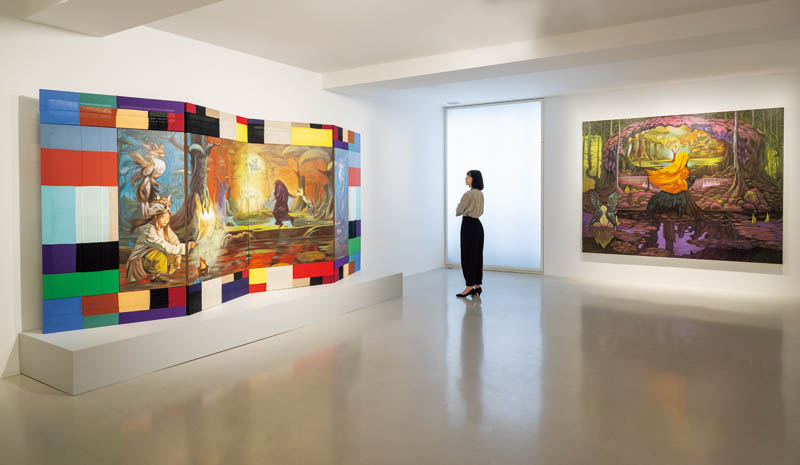
Zadie Xa’s Rough Hands Weave a Knife exhibition, held at Thaddaeus Ropac Paris Marais in 2024.
Courtesy of Thaddaeus Ropac, London · Paris · Salzburg · Milan · Seoul
© Zadie Xa
Xa’s 2022 exhibition House Gods, Animal Guides and Five Ways 2 Forgiveness at Whitechapel Gallery in London demonstrated this synthesis through elaborate costumes and multimedia installations exploring cultural hybridity and fluid identities. Intricate textile works fused traditional Korean color theory with contemporary design sensibilities, while performances incorporated elements from Korean shamanic rituals and contemporary club culture. Through such multilayered works, Xa creates immersive environments that challenge cultural binaries and speak to the complexity of the diasporic experience, translating traditional cultural elements into contemporary global dialogues. Xa’s first solo exhibition in Korea came later, with Nine Tailed Tall Tales: Trickster, Mongrel, Beast at Space K in 2023, demonstrating how diasporic artists often gain international recognition before achieving prominence in their ancestral homeland.
Attempting to define “Korean-ness” in the work of rising young Korean women artists reveals that while their national identity is often a point of reference, their art goes beyond the boundaries of geographical or cultural labels. This is especially evident when comparing artists based in Korea to those from the Korean diaspora. Artists like Zadie Xa, for instance, often explicitly highlight Korean elements such as shamanic customs, traditional colors, and folklore in their works, reflecting a profound connection to their cultural roots. Yet, the very need to navigate diasporic identities often intensifies such artists’ exploration of Korean heritage, leading to reinterpretations that resonate globally.
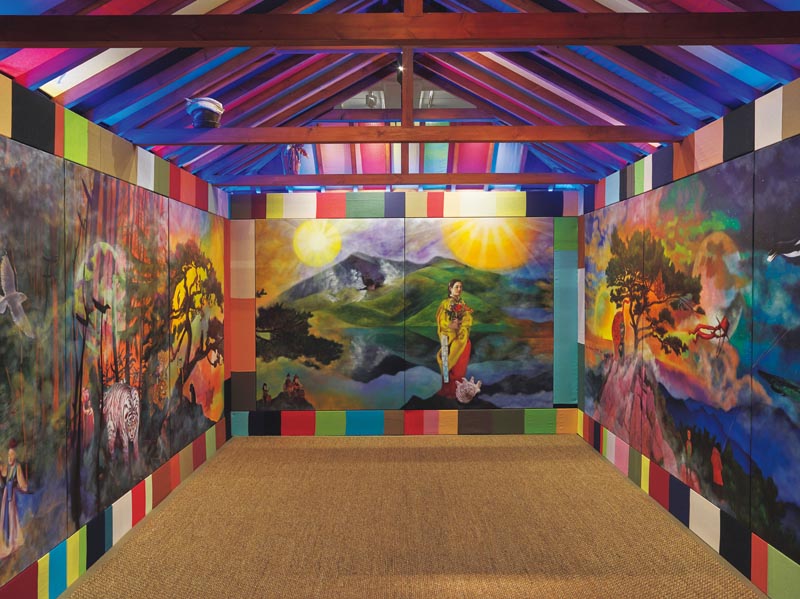
Installation image of House Gods, Animal Guides and Five Ways 2 Forgiveness, 2022, curated by Tarini Malik and Inês Costa. Whitechapel Gallery. Exhibition conceived and produced in collaboration with Benito Mayor Vallejo. Sound work made with Tom Slater.
Photo by Andy Keate
LOCAL SPECIFICITY, UNIVERSAL THEMES
Artists born and trained in Korea like Mire Lee and Geumhyung Jeong engage with cultural identity through an implicit, conceptual approach that reflects their lived experiences within contemporary Korean culture and society. While their works may not explicitly showcase Korean-ness, these artists embody Korea’s intricate and entangled relationship with industrialization, technology, and modernity. Lee’s visceral fusion of mechanical and organic forms echoes the tensions of rapid urban development, while Jeong’s intimate performances with machines probe the increasingly blurred boundaries between human and technological bodies in a hyper-connected society.
The contrasting approaches of diasporic artists and those born and raised in Korea demonstrate how Korean-ness emerges as a dynamic dialogue between personal experience, historical context, and global influences. This multiplicity of perspectives enriches our understanding of the scope of Korean contemporary art. The art of Lee, Jeong, and Xa challenges reductive notions of national identity, while highlighting the sophisticated ways in which contemporary artists navigate between local specificity and universal themes.
Through their distinct artistic languages, the three artists contribute to a broader reimagining of how Korean contemporary art engages with questions of identity, belonging, and cultural translation in our interconnected world. While they may represent just a few facets of Korea’s diverse contemporary art scene, their works exemplify how meaningful artistic innovation emerges from the productive tension between deep-rooted tradition and constant change, between honoring cultural heritage and pushing beyond its conventional boundaries. Gaining recognition on the global art stage, these artists are reshaping the contours of contemporary art.